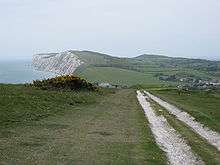Afton Down
| Afton Down | |
|---|---|
|
Afton Down viewed from Tennyson Down. | |
| Geography | |
| Location | Isle of Wight, England |
| Topo map | OS Landranger 196 |
Afton Down is a chalk down near the village of Freshwater on the Isle of Wight.[1] Afton Down faces Compton Bay directly to the west, while Freshwater is approximately one mile north.
It was the site of the Isle of Wight Festival 1970, where the Guinness Book of Records estimates 600,000 to 700,000, and possibly 800,000 people, flocked to see the musical talents of Emerson, Lake & Palmer, Free, The Who, The Doors, Ten Years After and Jimi Hendrix.[2]
In keeping with the native flora of Compton Bay, a variety of hardy plants grow on the down. Large European gorse bushes grow on the cliff, with the shelter they provide allowing other plants such as Wild cabbage and Bird's foot trefoil to thrive. Due to the strong prevailing wind from the English channel to the west, no large trees are able to grow on the down, allowing shrubs and grasses to thrive. The Isle of Wight's county flower, the Pyramidal Orchid, also grows here, along with Plantago lanceolata, the main food plant for the rare Glanville fritillary.
There is an obelisk on Afton Down near the cliff edge. It is inscribed with a memorial to a resident of one of the neighbouring villages who died after falling from the cliff in 1846. This obelisk was Grade II listed in 1994.
"E.L.M. Aged 15
He cometh forth like a flower and is cut down.
He fleeth also as a shadow and continueth not.
Erected in remembrance of a most dear and only child who was suddenly removed into eternity by a fall from the adjacent cliff on the rocks below.
28th August 1846.
Each side of the obelisk is inscribed with biblical passages in relation to the afterlife.

A local writer notes that it was common for people to climb the cliffs of the area to pick samphire, a plant used to make pickles.[3]
Freshwater Bay Golf Course is located on Afton Down.[4]
On the downs are a group of 24 barrows comprising, a long barrow 34.7m long, 0.9m high and oriented east-west, 17 bowl barrows, 4 bell barrows and 2 disc barrows (One of which is where the golf course is located). One barrow has been the subject of archaeological interest, and is thought to be from the Bronze Age.[5][6] The site was excavated in 1817 revealing nothing of significance in the long barrow, but several cremations in the round barrows.[1]
References
- 1 2 "Roman Britain - Afton Down". www.roman-britain.org. Archived from the original on 20 November 2008. Retrieved 2009-04-12.
- ↑ "Isle of Wight Festival History - 1970". www.isleofwightfestival.com. Archived from the original on 11 March 2009. Retrieved 2009-04-11.
- ↑ "Freshwater in the 17th Century". www.virgin.net. Retrieved 2009-04-12.
- ↑ "Isle of Wight golf at Freshwater Bay Golf Club". www.freshwaterbaygolfclub.co.uk. Archived from the original on 21 March 2009. Retrieved 2009-04-04.
- ↑ "Oxford Archaeology: Exploring the Human Journey". www.thehumanjourney.net. Archived from the original on 5 July 2007. Retrieved 2007-07-11.
- ↑ "Neolithic to Early Bronze Age Resource Assessment: The Isle of Wight" (PDF). www.thehumanjourney.net. Retrieved 2007-07-11.
Coordinates: 50°40′08″N 1°30′18″W / 50.669°N 1.505°W